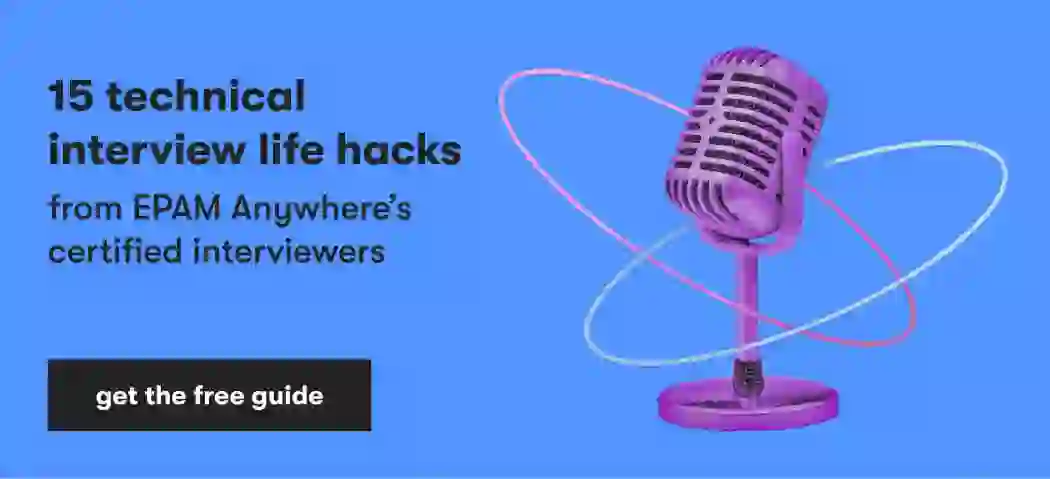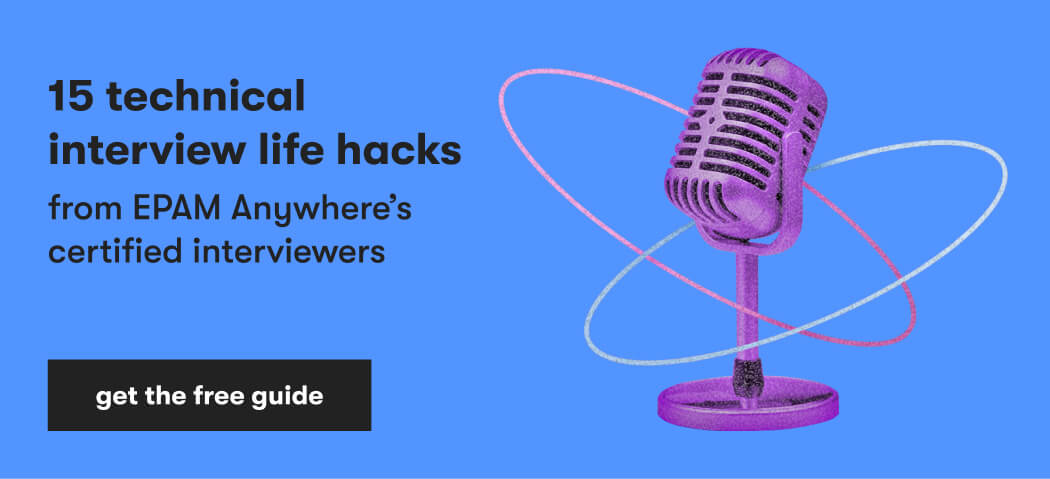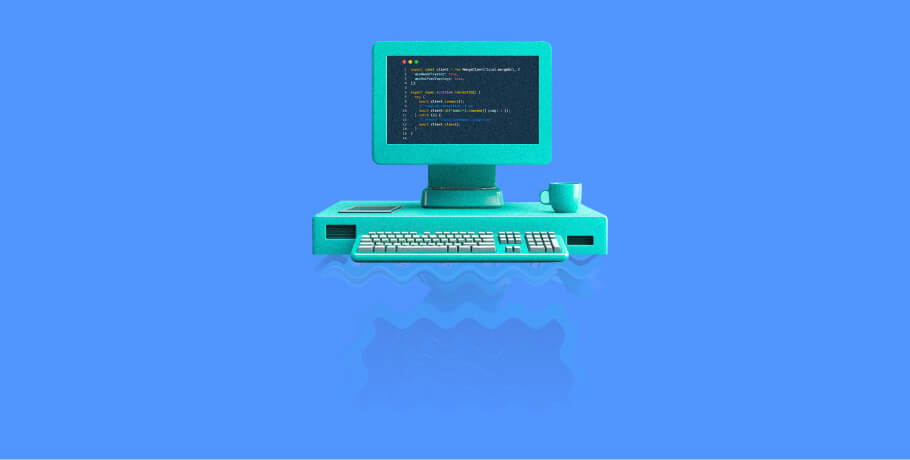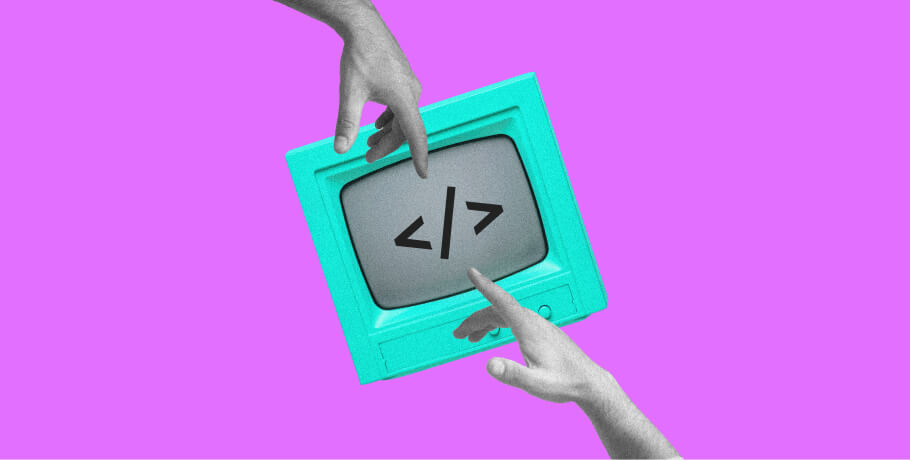When you’re a candidate interviewing for one of our remote IT jobs, ensuring you have fantastic answers to the interview questions at EPAM Anywhere is a must.
During the recruitment process, you’ll first meet with a recruiter to answer general interview questions (EPAM Anywhere style). Next, you’ll have a technical interview at Anywhere to showcase your practical skills. Finally, there’s an offer interview where you’ll get to explore your future role, followed by project and customer interviews to get the right fit.
To help you get ready for the EPAM Anywhere interview questions, here’s a look at our top 30 interview questions and answers.
want to work from Anywhere?
Say goodbye to the traditional office and hello to remote work with EPAM Anywhere. Take your career to new heights with us.
Top front-end interview questions at EPAM Anywhere
What are TypeScript essentials?
TypeScript is a JavaScript superset containing a single open-source compiler that’s primarily developed by Microsoft. It provides tools for catching mistakes quickly, improving development efficiency.
How does REST API work?
REST APIs work by fielding resource requests and returning relevant resource information in a format that’s easily interpreted by clients. Essentially, when a resource request is made, the REST API transfers the current resource state into a specified, standardized representation.
How is rebase different from merge in Git?
Both rebase and merge bring together the work of multiple developers to design one piece of code. However, rebasing moves the feature branch onto the main’s tip, creating a rewritten linear history. Merge joins development histories together, preserving the original history.
What’s the difference between classical and prototype inheritance?
With classical inheritance, you have two abstraction types: classes and objects. The process is limited, with classes only inheriting from other classes, creating subclass relationships with hierarchical taxonomies.
With prototype inheritance, there’s only one abstraction – objects – making it a generalization. The involved objects are creatable from nothing or from existing objects, with prototypes inheriting from other prototypes and objects inheriting from prototypes.
Have you ever worked with Scrum?
When answering this, you need to pull from your own applicable experience. To prepare for JavaScript interview questions of this nature, reflect on your past Scrum experience. If you’ve worked with it before, offer a clear example that shows your involvement. If not, answer honestly, but pivot to showcase your knowledge of Scrum to demonstrate your readiness.
Top Java interview questions at EPAM Anywhere
How do interfaces differ from classes?
While there are some nuances that differentiate interfaces from classes in specific scenarios, the key difference is that interfaces don’t have states, while classes do.
What are the advantages of microservices?
Microservices architecture is incredibly flexible and scalable. It’s also easily understood and offers quicker deployment, suggesting that continuous delivery is fine-tuned and well-set. Microservices also help to avoid fault isolation and provide faster recovery in some scenarios.
What’s an exception hierarchy?
The exception hierarchy in Java outlines how exceptions are categorized. The base of the exception hierarchy is the Throwable class, which serves as an Object subclass. Throwable is followed by two subclasses — Exception and Error, representing exceptional conditions and support code errors respectively — which are then broken down further based on the nature of the unexpected event.
Name some object-oriented programming limitations
While object-oriented programming is highly capable, there are notable limitations or disadvantages. OOP requires more lines of code, which some view as cumbersome. Some consider it slower or less efficient, particularly when it comes to CPU usage.
What’s the best way to work with technical documentation?
When you’re dealing with Java interview questions that ask why anything is the “best,” there isn’t one correct answer. Instead, you’ll need to outline your preferences and provide examples from your work history explaining why you favor a specific approach.
Top .NET interview questions at EPAM Anywhere
What’s JIT?
JIT stands for “just in time”. Part of the Common Language Runtime, the JIT compiler manages the execution of .NET programs regardless of the .NET programming language present. It effectively translates the code into its native equivalent at the time it’s required.
What’s serialization? Name the tools used for it.
Serialization involves saving an object’s state by converting it into a form that’s functionally a stream of bytes. The process ensures that the object is transportable across the network or persistent in a storage location.
Generally, there are four primary serialization types: Binary, SOAP, XML, and Custom. For an object class to be eligible for serialization, it must have the Serializable Attribute set. Some tools used for the process include BinaryFormatter and SoapFormatter.
Define the distinction between constants and read-only variables.
Constants are static by default — making them inaccessible in the context of an object — and initialized with a value when created. Read-only variables don’t require initial values, and values are changeable or assignable using the constructor of a class.
What’s the difference between encrypting a password and applying hashing?
Encryption involves converting plaintext into ciphertext, a process that’s reversible by using a decryption key to ensure passwords are recoverable should the need arise. Hashing is a one-way process, using hashing algorithms to convert passwords into ciphertext in a manner that isn’t recoverable later.
Name some popular .NET collection types
Some of the more popular .NET collection types are Array, List, Queue, Stack, Hashtable, SortedList, ArrayList, and Dictionary.
When you encounter .NET interview questions that ask for names, the easiest solution for a standout answer is presenting a relatively short list. With questions like this one, you aren’t required to include every collection type. Instead, stick with the most widely used.
Top QA interview questions at EPAM Anywhere
What types of software testing have you worked with?
With manual and automation testing interview questions of this nature, you need to focus on your unique experience. For a solid answer to EPAM Anywhere questions like this, outline the types of software testing you’ve handled, discussing examples that highlight your relevant experience and showcase your abilities.
Name some testing tools you’re familiar with
Like the question above, this is one of the automation and manual testing interview questions where you need to draw on personal experience. Consider what you’ve used in the past, name the tools, and briefly touch on how you used them.
Some testing tools you might discuss include: Selenoid, ReportPortal, TestNG, Rest Assured, Swagger, SOAP UI, Maven, and GitLabCI.
How is test strategy different from a test plan?
Test strategy is more conceptual, outlining primary goals relating to various techniques and covering the organization's overarching vision in regard to testing. A test plan is a document that defines the scope, objective, method, and weight. Essentially, the test strategy covers guiding principles that ensure any future test designs align with the company’s broader internal methodology, while the test plan is more formalized, discussing specific required processes, such as how and when to test and who’s responsible for testing what.
What details do you need to report a bug?
Generally, a bug report should contain a highly searchable and unique title, along with an overview of the bug that includes the noted behavior. Providing visual proof is beneficial, such as a screenshot, as well as defining the expected results and comparing this to what actually occurred.
Providing steps to reproduce the bug is also crucial for the report. Details about the environment are often necessary, such as the OS, browser, device type, screen size, and similar points. Offering logs makes identifying bugs that are harder to reproduce simpler, making them a good addition. Finally, including a priority and severity is critical to ensure that the correct bugs take precedence over others.
What tests should be automated?
Tests that are repeatable and frequently executed are prime targets for automation, as well as testing where manual methods don’t return a positive ROI. Automation is preferable for tests that involve simultaneously running sets of test cases. When a tested feature is a top business priority or requires minimal change, automation is also preferred. Finally, automating tests that involve extended complexity is typically best.
save your time on job search
Send us your CV and we'll match your skills with our jobs while you get ready for your next technical interview
Top DevOps interview questions at EPAM Anywhere
Name the categories of some common DevOps tools
The DevOps tool categories include version control system, continuous integration, continuous testing, confirmation management and deployment, continuous monitoring, and containerization.
With DevOps interview questions like this one, you can simply present your answer as a list. However, you also have the option of mentioning your experience with each tool category or discussing tools that align with each group. If you do, keep those descriptions brief, as you’re likely to face more questions during your EPAM Anywhere interview specifically about your tool use.
How is continuous integration different from continuous deployment?
In the simplest sense, continuous integration is a form of build automation, while continuous deployment involves automated releases.
With continuous integration, changes are merged into the code as rapidly as possible. Any changes are validated through automated testing, and if they pass, the merge occurs. If not, merges don’t happen.
Continuous deployment is a subsequent step, trailing behind an integration. It involves the automatic deployment of changes that pass automated tests, essentially releasing them into production. The only issue that would prevent a deployment is failed verifications during the integration phase.
Define blue-green deployments
A blue-green deployment is a release model commonly used with continuous deployment strategies. It involves transitioning users between two nearly identical releases that are both in production as a means of eliminating downtime.
The blue environment is the older version, while the green environment is the newer one. During the transition to the green environment, the blue environment remains fully operational. Should issues occur with the green environment, the blue environment acts as a rollback option for near-immediate recovery. If a rollback isn’t required, the blue environment can remain as a recovery option or serve as a container for the next update.
What DevOps tools do you commonly use?
When answering this one — or any questions that are similar — discuss the DevOps tools you’ve used frequently, adding details into your answer to cover how and why you’ve used them in the past.
What’s the difference between DevOps and Agile?
DevOps differs from Agile in a few ways. Agile is incredibly development-focused, concentrating primarily on how tasks are accomplished to support efficient development. Agile is highly iterative, focusing on minor, rapid releases and emphasizing functional and non-functional readiness.
DevOps also supports quick development, but its focus is on bringing development and operations together, ensuring two traditionally siloed teams are highly involved in the process. The team size is typically larger, and communication and collaboration are priorities. There’s also greater emphasis placed on business readiness and operations in DevOps environments.
Often, Agile and DevOps are viewed as different but complementary. Agile supports rapid change to adapt to shifting requirements, while DevOps encourages automated continuous integration and deployment to support frequent releases.
Top Python interview questions at EPAM Anywhere
What is PEP8?
PEP8 is a coding style that’s designed to improve code readability. In the PEP8 document, there are guidelines and best practices for writing code in Python. By aligning with the framework, the code is easier to review visually. Plus, it ensures the code relies on known conventions, including logical whitespace use and sound commenting, to make code easier to review or come back to as necessary. Essentially, PEP8 aims to improve overall code clarity and create consistency, leading to better collaboration and simplifying the process of applying future updates or changes.
What are list comprehension and dictionary comprehension?
Comprehension is an approach for constructing dictionaries and lists in Python, creating the ability to loop through and filter existing data or sequences. List comprehension involves an array of objects stored in sequential order, essentially serving as a more refined way to create lists than traditional for-loops. Dictionary comprehension involves stored arrays of objects that are accessible using keys, serving as a sophisticated method for creating dictionaries from iterables or by transforming an existing dictionary into another.
Did you work with parallelization in Python?
As one of the personal experience-oriented senior software engineer interview questions, your answer needs to accurately describe your experience with parallelization. Along with stating whether you’ve worked with parallelization in the past, you’ll want to expand your response to make it impactful. If you have experience, discuss some examples. If not, outline your knowledge of parallelization to show you’re ready to work with it.
Which types of polymorphism do we have in Python?
In Python, the broad categories of polymorphism are subtype (also known as runtime and overriding), parametric (overloading), ad hoc (compile-time), and coercion (casting).
When you answer this question, you can give more specific or advanced examples within the broader type. You can also discuss instances where you’ve used each technique to create a comprehensive answer.
When should you use aggregation vs. inheritance?
With inheritance, you extend a class’s functionality by creating a subclass. Aggregation involves creating new functionality by selecting existing classes and combining them, leading to a new class. Typically, inheritance is best in scenarios where the new class is highly similar to the original, as it inherits both the interface and implementation. With aggregation, you have the ability to include both the interface and implementation or select one or the other, making it a better option when the new class isn’t serving as a pure extension of an existing class’s functionality.
Final tips for passing an EPAM Anywhere interview
Regardless of where you’re interviewing, it’s normal to feel a little nervous or anxious about answering the questions you’ll encounter. When you’re getting ready to answer interview questions at EPAM Anywhere, specific interview best practices ensure you’ll make a positive impression.
Here are some remote interview tips for handling EPAM Anywhere interview questions, increasing your odds of coming across as a strong applicant and advancing through the selection process:
- Choose a quiet, controlled location for your interview.
- Turn off notifications on any nearby device before your interview.
- Do a technology check to ensure your device, internet connection, and any involved equipment or software are functioning correctly before your interview.
- Practice describing work examples that showcase your technical and soft skills.
- Focus on your contributions, not the efforts of the entire team.
- Use professional terminology without diving into jargon that isn’t universally familiar.
- If you aren’t sure about a topic, describe how you’d get the needed information instead of simply stating that you don’t know the answer.
- Use research to refresh your memory on key concepts relating to your target position.
- Keep your answers concise and straightforward, avoiding embellishments.
- Ask the interviewer questions if you need clarification.
- Pause before answering to give yourself a chance to form a strong answer.
- Use the STAR (Situation, Task, Action, Result) method for behavioral and situational interview questions.
By using the tips above, your odds of having a successful EPAM Anywhere interview and securing a better job go up dramatically. Make sure you’re confident throughout the meeting and practice answers to common questions like those above. That way, you’ll be ready to impress, making it easier to achieve your career goals.

As Chief Editor, Darya works with our top technical and career experts at EPAM Anywhere to share their insights with our global audience. With 12+ years in digital communications, she’s happy to help job seekers make the best of remote work opportunities and build a fulfilling career in tech.
As Chief Editor, Darya works with our top technical and career experts at EPAM Anywhere to share their insights with our global audience. With 12+ years in digital communications, she’s happy to help job seekers make the best of remote work opportunities and build a fulfilling career in tech.
Explore our Editorial Policy to learn more about our standards for content creation.
read more


























